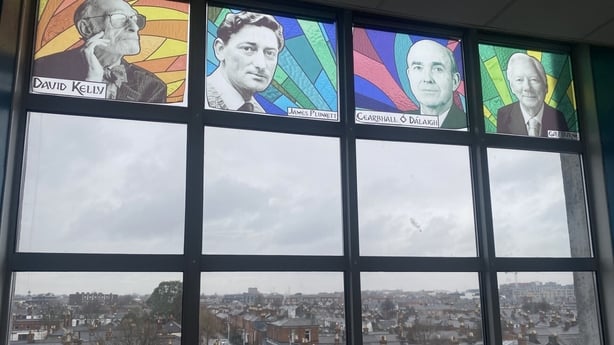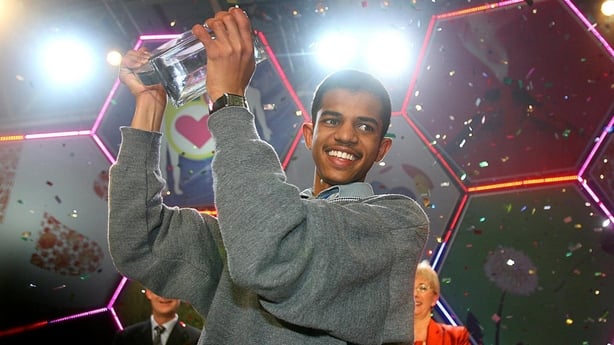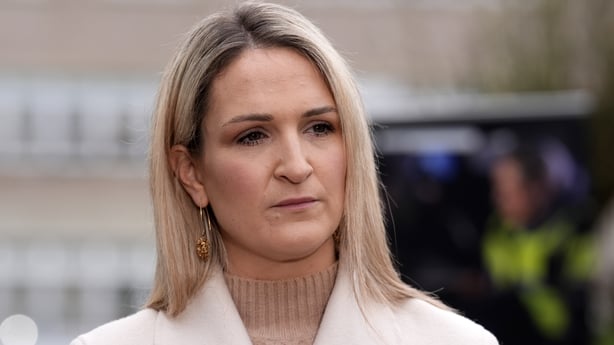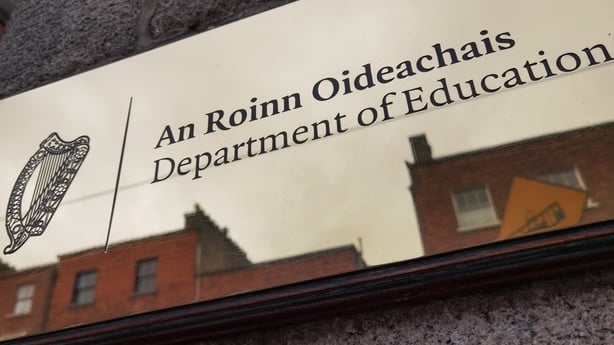On the third floor of the Synge Street CBS building, the windows that stretch along its corridor seem to encapsulate the school's history.
Facing west, the view reaches out for miles across this part of Dublin’s south city, beyond a myriad of victorian rooftops and chimneys, interspersed with 1950s flats complexes and church spires, one of which belongs to a former Christian church building that has long housed the South Circular Road Mosque.
Along the top panes, the school has placed mosaics of some of its famous past pupils; Cearbhall Ó Dálaigh, Gay Byrne, Ronny Drew, James Cosgrave, James Plunkett, the list seems endless.
Even on the grey February day that we visited, the panels are illuminated.
Synge Street stands as a symbol of key phases in the history of Irish education.
Its rollcall of past pupils redolent of a long era when in schools across the country the Christian Brothers churned out armies of educated young men from humble backgrounds to populate the civil service and other key arms of a fledgling state.

Of the ones who rose to become taoisigh, presidents and other icons of Irish political or cultural life, Synge Street seems to have produced more than its fair share.
In recent decades, the school came to symbolise something else.
As secondary schools were constructed across the city’s burgeoning suburbs and boys there could be educated closer to home, Synge Street narrowed its focus to the boys from the streets and flats complexes that surround it.
This part of Dublin has long been at the vanguard of social change. It is where Jewish immigrants settled in the late 19th century. By the 1980s and 90s, a muslim community was putting down roots.
Educating the sons of local working class and immigrant families, once again Synge Street excelled. Its record at the BT Young Scientist Exhibition in recent decades is second to none. It has taken the top prize more than any other school and among the winners are many boys from humble immigrant and working class backgrounds.

The magnitude of that achievement, by a DEIS school, cannot be understated.
But while all this was happening, for some close to the school, Synge Street had also come to symbolise something else; the inertia of the State and those who control our schools in the face of a crying need for modernisation.
For decades, Synge Street CBS has been left to languish, its enrolment falling as a growing number of families searched - fruitlessly in many cases - for the new kind of education they wanted for their children.
Growing need for change evident
All the evidence shows that Irish families increasingly want co-education, many no longer want a Catholic education, and a growing number too want education through Irish.
This is particularly true of families living in large urban areas such as Dublin.
The growing need for change has been evident for decades, but it seems the State has only belatedly recognised that action is required.
"We are a modern European capital city, but where is our Lycée?"
While Synge Street enjoyed its successes at the BT Young Scientist, behind the scenes its staff struggled to ensure that they could continue to provide subjects, such as higher level maths and physics, for the highly intelligent and capable boys among their students who wanted those subjects. Against the odds they always managed to pull it off.
Sitting in his office years ago, former principal Dr Michael Minnock lamented the paralysis he felt that gripped the system.
"We are a modern European capital city, but where is our Lycée?" he asked me. (A Lycée is the French model of state schooling that provides free, non-religious, education to allcomers).
Mr Minnock felt that Synge Street was ideally placed to become such a school.
Now, belatedly, it seems the powers-that-be have come to agree with him.
Last September, with a general election looming, the then Minister for Education Norma Foley rushed to announce a new direction for Synge Street – from September 2026 the school would begin a phased shift towards co-educational Gaelcholáiste status.
The desperate need for such a school in this part of South Dublin, articulated by highly organised parents in a strong campaign group, needed to be addressed.
The news – broken to Synge Street staff just the evening before the announcement – landed on the school like a sledgehammer.
What about their jobs and their futures, teachers asked. What about their school community, those immigrant and other local families for whom the prospect of an education through Irish might feel like a step too far?
School breaks silence
For months since then, staff at the school looked for answers, for information, but they say none were forthcoming, and this week they broke their silence. They spoke out and said 'no’.
The school is refusing to proceed with the plan in 2026. Through its patron body ERST it informed the Department of Education this week that it would not be implementing the change.

Interestingly, while 90% of the staff in a survey said they were against becoming a gaelcholáiste, almost the same proportion said they would favour becoming co-educational.
What now for Synge Street? And what now for the campaign for a Gaelcholáiste for the area? With six primary Gaelscoileanna nearby and no second level scoil lángaelach for those children to progress to that need is undeniable and it is recognised by the department and the new Minister for Education Helen McEntee.
Synge Street school is not against change, and ironically it is no stranger to Irish language education.
A past pupil told me recently of how all of his education there in the 1960s – apart from religion and Latin - was through the medium of Irish.
Read more: Department committed to Synge Street CBS Gaelcholáiste switch
While immigrant families whose first language may not be English are understandably reluctant to send their children to Irish language schools, it also needs to be said that children from these kinds of backgrounds often excel at the language and can thrive in a Gaelscoil setting.

Their multi-lingualism gives them an edge over children from monolingual native Irish backgrounds.
One local gaelscoil, Gaelscoil Inse Chór, told me that 35% of their intake is children with at least one foreign-born parent.
When it comes to talk of change, school ethos also cannot be ignored. While the local campaign for a Gaelcholáiste has not specified a desire for any particular ethos, many of the parents involved in that campaign are also involved in another campaign for a multi-denominational school for this part of the city.
One parent involved in the campaign tells me that while a Gaelcholáiste is her priority, ideally she would like that school to be "non-denominational".
Questions over Synge Street's Catholic ethos
Mr Minnock is not the only person connected with the school in days gone by to question the idea of the school continuing with its Catholic ethos in this day and age.
Another person with a long and close connection to the school in the past put it very bluntly when they spoke to me on the phone on Friday.
This person, who did not want to be identified, professed "huge respect" for the Christian Brothers whose trust, the Edmund Rice Schools Trust (ERST) continues as patron of the school.
But he described the school’s continuing Catholic ethos as "like a dead hand reaching beyond the grave".
"They are trying to hold on to something that has passed, and that is coming at a cost to the kids", he said.
What lies ahead now for Synge Street? The school and its community has been plunged into crisis.
For the families who were intending to enrol their children there how do they know what lies ahead?
A pathway needs to be found, and urgently.
Once again, the school finds itself at the centre of a wider story in Irish education; the pressing need for change on a variety of fronts, to co-education, to a broader ethos framework and to Irish language education for those who want it.
How change here is managed and what becomes of this school, with its long history and outstanding service to generations of boys, will be a litmus test.







